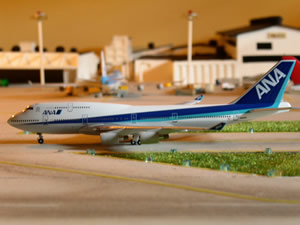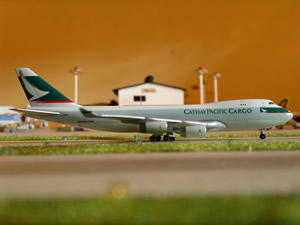

From the beginning, Boeing 747 was designed to serve as an all-cargo transport. The first Boeing 747 Freighter could easily carry 100 tons (90,000 kg) across the Atlantic Ocean or across the United States. Its operating cost was 35 percent less per ton mile than 707 Freighter. Boeing 747 Freighter has a hinged nose to allow cargo loading through front of the airplane, with the option of a large side-cargo door.
Boeing Boeing 747-200 Convertible was configured to serve as a passenger airplane, a freighter or a combination of both. This airplane responded to airlines' needs to carry different payloads at different times of the year, such as higher passenger capacities during the summer and more cargo during the winter. Similar to the convertible is -200 Combi, which was designed to serve as a passenger-only airplane or as a passenger-freighter mix.
Combi has a large side-cargo door on the main deck and is used by airlines to make better use of their routes during different times of the year. The convertible has a nose cargo door similar to freighter.

|
Power Plant |
|
|
|
|
|
|
Fuel Capacity |
|
|
| In integral tanks in wings and centre section |
43,641
Imp gal (198,390 L)
|
|
| In two optional outboard reserve tanks |
plus 1,312 Imp gal (5,966 L)
|
|
| In optional fuselage tank |
plus
1,432 Imp gal (6,511 L)
|
|
|
Weight |
|
|
| Operating weight empty |
375,170
lb (1 70,180 kg);
|
|
| Maximum fuel |
353,760
lb (160,463 kg);
|
|
| Maximum payload |
151,500
lb (68,719 kg)
|
|
| Maximum take-off, basic aircraft |
800,000
lb (362,875 kg)
|
|
| Maximum take-off, optional, |
820,000
lb (371,945 kg) or 833,000 lb (377,840 kg)
|
|
| Maximum landing, for take-off weights quoted above |
564,000
lb (255,825 kg) , or 585,000 lb (265,350 kg) or 630,000 lb (285,765
kg) respectively
|
|
| Maximum zero-fuel weight, all options, |
526,5001b
(238,815kg)
|
|
|
Performance |
||
| Maximum operating speed |
375
kts (695 km/h) IAS or Mach = 0.92
|
|
| Maximum cruising speed |
507
kts (940 km/h) at 35,00O ft (1 0,670 m)
|
|
| Long-range cruise |
484
kts (897 km/h) at 35,00O ft (1 0,670 m)
|
|
| Cruise ceiling |
45,00O
ft (1 3,715 m)
|
|
| Take-off field length (FAR) |
10,40O ft (3,170 m)
|
|
| Landing field length (FAR) |
6,95Oft
(2,120m)
|
|
| Range with full passenger payload |
6,150
naut mls (1 1,402 km)
|
|
| Range with maxfuel |
7,
100 naut mls (1 3,163km)
|
|
|
Wing Span |
195
ft 8 in (59.64 m)
|
| Overall Length |
23
1 ft 1 O in (70.66 m)
|
| Tail Height |
63
ft 5 in (19.33 m)
|
| Interior Cabin Width | |
| Sweepback |
37
deg 30 min at quarter chord
|
| Wing area |
5,500
sq ff (510.95 M2)
|
| Cabin length |
187
ft O in (57.00 m)
|
| Moximum width |
20
ft 1 1/2 in (6.13 m)
|
| Maximum height |
8
ft 4 in (2.54 m)
|
| Underfloor baggage/cargo volume |
5,1
90 cu ft (1 46.96 m )
|
| Alternative one-class layouts |
447
nine-abreast, or
516 ten-abreast |
| 3 Views |
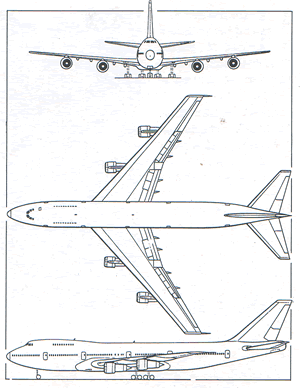 |
| First class |
32
|
| Economy class |
388
|
| Upper deck |
32
|
| Flight crew |
3
|
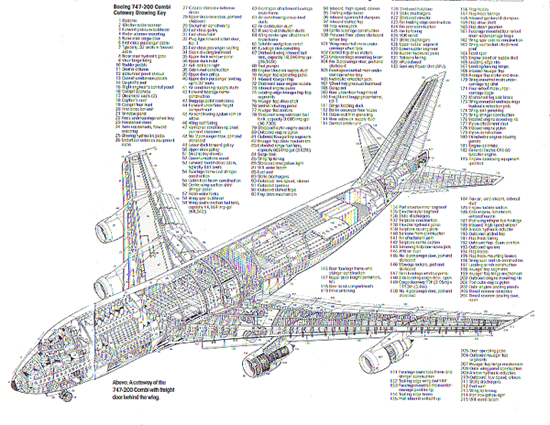

|
Power Plant |
|
|
|
|
|
|
Fuel Capacity |
|
|
| In integral tanks in wings and centre section |
43,641 Imp gal (198,390 L)
|
|
| In two optional outboard reserve tanks |
plus
1,312 Imp gal (5,966 L)
|
|
| In optional fuselage tank |
plus
1,432 Impgal (6,511 L)
|
|
|
Weight |
375,170
lb (1 70,180 kg)
|
|
| Operating weight empty |
384,480
lb (1 74,400 kg)
|
|
| Maximum fuel |
353,760 lb (1 60,463 kg)
|
|
| Maximum payload |
151,000
lb (68,492 kg)
|
|
| Boeing 747-300M Combi Maximum payload |
181,000
lb (82,100 kg)
|
|
| Maximum take-off, basic aircraft |
800,000
lb (362,875 kg)
|
|
| Maximum take-off, optional, |
820,000 lb(371,945 kg), or
833,000 lb (377,840 kg) |
|
| Maximum landing, for take-off weights quoted above |
574,000
lb (260,360 kg), or
585,000 lb (263,350 kg), or 630,000 lb (285,765 kg) respectively |
|
| Maximum zero-fuel weight, passenger aircraft, |
535,000
lb (242,670 kg)
|
|
| Maximum zero-fuel weight, Boeing 747-300M Combi, |
565,000
lb (256,280 kg)
|
|
|
Performance |
||
| Maximum operating speed |
3751kts
(695 km/h) IAS or Mach = 0,92
|
|
| Maximum cruising speed |
5071kts
(940 km/h) at 35,000 ft (10,670 m)
|
|
| Long-range cruise |
490
kis (908 km/h) at 35,000 ft (10,670 m)
|
|
| Cruise ceiling |
45,000
ft (13,715 m)
|
|
| Take-off field length (FAR) |
10,450 ft (3,185 m)
|
|
| Landing field length (FAR) |
6,920 ft (2,110 m)
|
|
| Range with full passenger payload |
5,650
naut tmis (10,475 km)
|
|
|
Wing Span |
195 ft 8 in (59.64 m)
|
| Overall Length |
231
ft 1 0 in (70.66 m)
|
| Tail Height |
63
ft 5 in (19.33 m)
|
| Interior Cabin Width | |
| Sweepback |
37
deg 30 min at quarter chord
|
| Wing area |
5,500
sq ft (510.95 M2)
|
| Cabin length |
187
ft 0 in (57. 00 m)
|
| Moximum width |
20 ft 1 1/2 in (6.13 m)
|
| Maximum height |
8 ft 4 in (2.54 m)
|
| Underfloor baggage/cargo volume |
5,1
90 cu ft (147 M3)
|
| Boeing 747-300SR short-range version |
624
high density
|
| 3 Views |
 |
| First class |
18
at 62 in (1.57 m) pitch
|
| Business class |
52
at 36in (91cm) pitch
|
| Economy class |
at
34 in(86 cm) pitchallon main deck
|
| Upper deck |
plus
69 economy class, or
42 business class, or 38/26 first class on extended upper deck. |
| Flight crew |
3
|
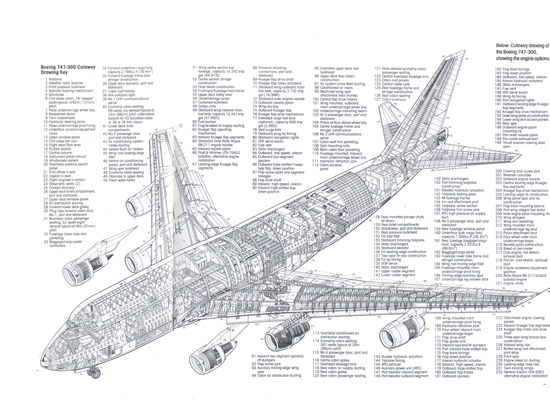
Boeing has designed or modified 15 Boeing 747s for special purposes. Among them were two Boeing 747-200s delivered as U.S. presidential Air Force One airplanes and four Boeing 747-200s, designated E-4s, delivered to the U.S. Air Force as airborne emergency command and control posts. Another Boeing 747 was modified to ferry the U.S. space shuttle between California and Florida. Other Boeing 747s have been demonstrated as tankers capable of refueling other airplanes in flight.
In addition, Boeing completed modifications to 19 existing Boeing 747-100s to Civil Reserve Air Fleet (CRAF) configurations in 1990. If called into service by the U.S. Air Force, these passenger planes can be converted to freighters in less than 48 hours. Boeing donated the original Boeing 747, line No. 1, to Seattle's Museum of Flight. On lease to Boeing, it often is used as a flying testbed for aeronautical developments

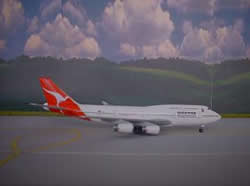
From its first flight in 1969, Boeing 747 has been an airplane of superlatives: It was bigger, flew farther and carried more people than any other commercial airplane. Today, that's still true. The latest model, Boeing 747-400, can fly 416 to 524 passengers about 8,400 miles and is available in four models. Boeing 747-400 has a two-pilot digital flight deck, a new interior and is powered by stronger, more efficient engines. With its huge capacity, extended range and improved fuel
efficiency, the -400 offers the lowest operating costs per seat of any commercial jetliner. In addition to passenger version, Boeing 747-400 is offered as a "Combi" -- carrying passengers forward and cargo aft on the main deck -- as well as a domestic, high-capacity version and an all-cargo freighter.
Boeing is continuing the development of Boeing 747-400 and building on its strengths to fulfill future requirements of the small but important Boeing 747-and-larger airplane market. Boeing is developing a 21st century family of Boeing 747 derivatives to be well positioned if customer demand and market requirements warrant moving forward.
| Engines maximum thrust |
Pratt & Whitney PW4062
|
63,300 lb (28,710 kg)
|
|
Rolls-Royce RB211-524H
|
59,500 lb (26,990 kg)
|
|
|
General Electric CF6-80C2B5F
|
62,100 lb (27,945 kg)
|
|
| Maximum Fuel Capacity |
57,285 U.S. gal (216,840 L) |
|
| Maximum Takeoff Weight |
875,000 lb (396,890 kg) |
|
| Maximum Range
|
|
|
| Typical Cruise Speed at 35,000 feet |
0.85 Mach 565 mph (910 km/h) |
|
 |
||
| Wing Span |
211 ft 5 in (64.4 m) |
| Overall Length |
231
ft 10 in (70.6 m)
|
| Tail Height |
63
ft 8 in (19.4 m)
|
| Interior Cabin Width |
20
ft (6.1 m)
|
| 3 Views |
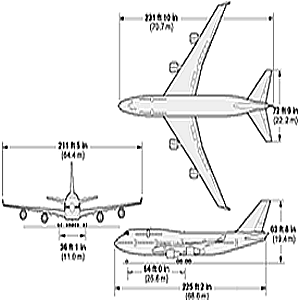 Boeing 747-400 advanced long-range airliner (General Electric CF-80C2 engines) |
|
|
|
Cargo |
6,025 cu ft (170.61 cu m) |
| NOTE |
|
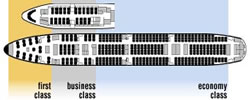 Representative Boeing 747-400 interior configurations for dual- or multiple-class travel |
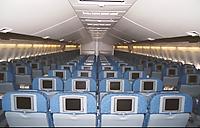 |
 |
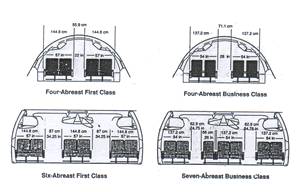 |
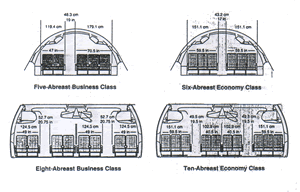 |
|
Cross
section of Boeing 747 showing low- and medium-density seating.
|
Boeing
747 medium- and high-density seating.
|
| Engines maximum thrust |
Pratt & Whitney PW4062
|
63,300 lb (28,710 kg)
|
|
Rolls-Royce RB211-524H
|
59,500 lb (26,990 kg)
|
|
|
General Electric CF6-80C2B5F
|
62,100 lb (27,945 kg)
|
|
|
Maximum Fuel Capacity |
57,285 U.S. gal (216,840 L) |
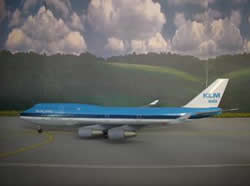 |
|
Maximum Takeoff Weight |
875,000 lb (396,890 kg) |
|
|
Maximum Range |
|
|
|
Typical Cruise Speed at 35,000 feet |
0.85 Mach 565 mph (910 km/h) |
|
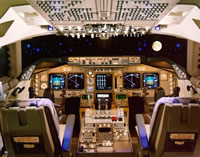 |
||
|
Wing Span |
211 ft 5 in (64.4 m) |
| Overall Length |
231 ft 10 in (70.6 m)
|
| Tail Height |
63 ft 8 in (19.4 m)
|
| Interior Cabin Width |
20 ft (6.1 m)
|
| 3 Views |
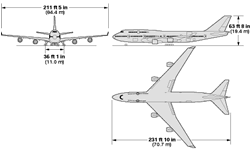 |
|
|
|
Cargo |
|
| NOTE |
|
 Combi interiors, showing all-passenger and passenger/freight arrangments |
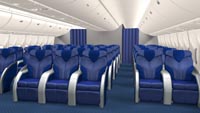 |
 |
|
Engines maximum thrust |
Pratt & Whitney 4062
|
63,300 lb (28,710 kg)
|
|
Rolls-Royce RB211-524H
|
59,500 lb (26,990 kg)
|
|
|
General Electric CF6-80C2B5F
|
62,100 lb (27,945 kg)
|
|
|
Maximum Fuel Capacity |
53,985 U.S. gal (245,421 L) |
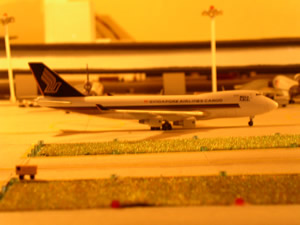 |
|
Maximum Takeoff Weight |
870,000 lb (391,500 kg) |
|
|
Maximum Range |
4,445 nautical miles (8,232 km) |
|
|
Typical Cruise Speed at 35,000 feet |
0.85 Mach 565 mph (910 km/h) |
|
Wing Span |
211 ft 5 in (64.4 m) |
| Overall Length |
231 ft 10 in (70.6 m)
|
| Tail Height |
63 ft 8 in (19.4 m)
|
| Interior Cabin Width |
20 ft (6.1 m)
|
| 3 Views |
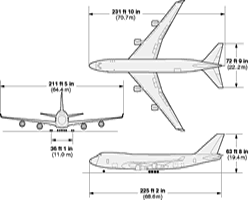 |
|
Maximum Payload |
244,000 lbs (109,800 kg) |
| Maximum Volume |
27,467 cu ft (777.9 cu m) |
| Main Deck Cargo | Thirty 96x125 inch main deck pallets |
| Lower Hold Cargo |
Nine 96x125 inch lower hold pallets, two LD-1s and 520 cubic feet in the bulk area |
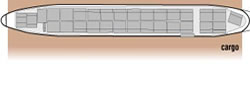 |
|
 |
